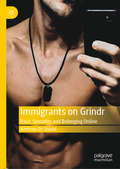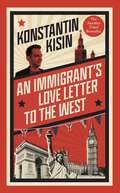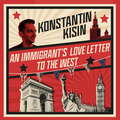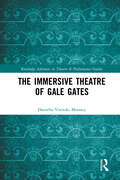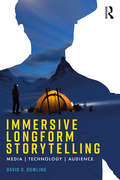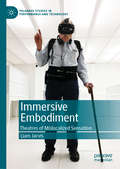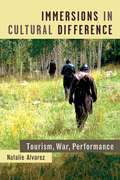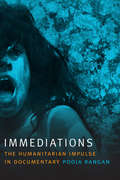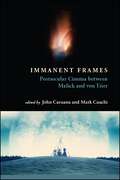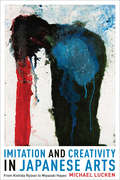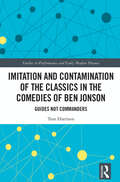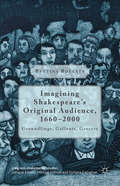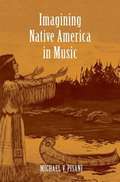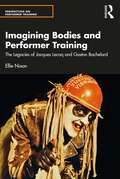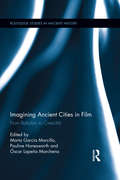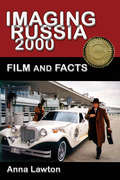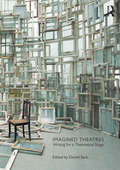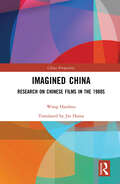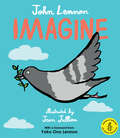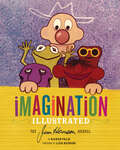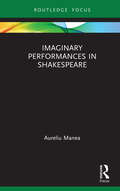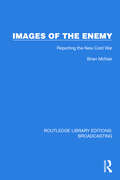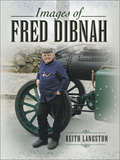- Table View
- List View
Immigrants on Grindr: Race, Sexuality and Belonging Online
by Andrew DJ ShieldThis book examines the role of hook-up apps in the lives of gay, bi, trans, and queer immigrants and refugees, and how the online culture of these platforms promotes belonging or exclusion. Within the context of the so-called European refugee crisis, this research focuses on the experiences of immigrants from especially Muslim-majority countries to the greater Copenhagen area, a region known for both its progressive ideologies and its anti-immigrant practices. Grindr and similar platforms connect newcomers with not only dates and sex, but also friends, roommates and other logistical contacts. But these socio-sexual platforms also become spaces of racialization and othering. Weaving together analyses of real Grindr profile texts, immigrant narratives, political rhetoric, and popular media, Immigrants on Grindr provides an in-depth look at the complex interplay between online and offline cultures, and between technology and society.
An Immigrant's Love Letter to the West
by Konstantin KisinFor all of the West's failings - terrible food, cold weather, and questionable politicians with funny hair to name a few - it has its upsides. Konstantin would know. Growing up in the Soviet Union, he experienced first-hand the horrors of a socialist paradise gone wrong, having lived in extreme poverty with little access to even the most basic of necessities. It wasn't until he moved to the UK that Kisin found himself thriving in an open and tolerant society, receiving countless opportunities he would never have had otherwise.Funny, provocative and unswervingly perceptive, An Immigrant's Love letter to the West interrogates the developing sense of self-loathing the Western sphere has adopted and offers an alternative perspective. Exploring race politics, free speech, immigration and more, Kisin argues that wrongdoing and guilt need not pervade how we feel about the West - and Britain - today, and that despite all its ups and downs, it remains one of the best places to live in the world.After all, if an immigrant can't publicly profess their appreciation for this country, who can?
An Immigrant's Love Letter to the West
by Konstantin KisinFor all of the West's failings - terrible food, cold weather, and questionable politicians with funny hair to name a few - it has its upsides. Konstantin would know. Growing up in the Soviet Union, he experienced first-hand the horrors of a socialist paradise gone wrong, having lived in extreme poverty with little access to even the most basic of necessities. It wasn't until he moved to the UK that Kisin found himself thriving in an open and tolerant society, receiving countless opportunities he would never have had otherwise.Funny, provocative and unswervingly perceptive, An Immigrant's Love letter to the West interrogates the developing sense of self-loathing the Western sphere has adopted and offers an alternative perspective. Exploring race politics, free speech, immigration and more, Kisin argues that wrongdoing and guilt need not pervade how we feel about the West - and Britain - today, and that despite all its ups and downs, it remains one of the best places to live in the world.After all, if an immigrant can't publicly profess their appreciation for this country, who can?
An Immigrant's Love Letter to the West (Karen Pirie #4)
by Konstantin KisinTHE SUNDAY TIMES BESTSELLER'A lively and spirited book' DOUGLAS MURRAY'A paean to the freedom and dignity that many in the West take for granted' PETER BOGHOSSIAN'A cool, steady but urgent message that we should value and protect what we have' SPIKED'Kisin's book [has] a powerful moral quality that makes it worth reading' SUNDAY TIMESFor all of the West's failings - terrible food, cold weather, and questionable politicians with funny hair to name a few - it has its upsides. Konstantin would know. Growing up in the Soviet Union, he experienced first-hand the horrors of a socialist paradise gone wrong, having lived in extreme poverty with little access to even the most basic of necessities. It wasn't until he moved to the UK that Kisin found himself thriving in an open and tolerant society, receiving countless opportunities he would never have had otherwise.Funny, provocative and unswervingly perceptive, An Immigrant's Love letter to the West interrogates the developing sense of self-loathing the Western sphere has adopted and offers an alternative perspective. Exploring race politics, free speech, immigration and more, Kisin argues that wrongdoing and guilt need not pervade how we feel about the West - and Britain - today, and that despite all its ups and downs, it remains one of the best places to live in the world.After all, if an immigrant can't publicly profess their appreciation for this country, who can?
The Immersive Theatre of GAle GAtes (Routledge Advances in Theatre & Performance Studies)
by Daniella Vinitski MooneyThis book focuses on experimental theatre company, GAle GAtes, credited as "the true innovator" of the contemporary immersive movement. The Immersive Theatre of GAle GAtes is a case-study of this little-known but visionary company, with a focus on its development and dramaturgy. Through rare archival and primary research, as well as historical context, the text chronicles company narrative and celebrates the artistic impulse. The book employs descriptive-narrative and dramaturgical analysis and is composed of historical research, rare archives, and primary source interviews. Chapters focus on the trajectory of the avant-garde leading up to the climate in which the company formed, company formative years, and major works and a discussion on the interdisciplinary and theoretical frameworks critical to its understanding. This study will be of great interest to students and scholars in theatre and performance studies and essential reading for theatre artist and historian alike, with a focus on the experimental theatre landscape.
Immersive Longform Storytelling: Media, Technology, Audience
by David DowlingA deep dive into the world of online and multimedia longform storytelling, this book charts the renaissance in deep reading, viewing and listening associated with the literary mind, and the resulting implications of its rise in popularity. David O. Dowling argues that although developments in media technology have enabled the ascendance of nonfictional storytelling to new heights through new forms, it has done so at the peril of these intensely persuasive designs becoming deployed for commercial and political purposes. He shows how traditional boundaries separating genres and dividing editorial from advertising content have fallen with the rise of media hybridity, drawing attention to how the principle of an independent press can be reformulated for the digital ecosystem. Immersive Longform Storytelling is a compelling examination of storytelling, covering multimedia features, on-demand documentary television, branded digital documentaries, interactive online documentaries, and podcasting. This book’s focus on both form and effect makes it a fascinating read for scholars and academics interested in storytelling and the rise of new media.
Immersive Embodiment: Theatres of Mislocalized Sensation (Palgrave Studies in Performance and Technology)
by Liam JarvisThis book offers a wide-ranging examination of acts of ‘virtual embodiment’ in performance/gaming/applied contexts that abstract an immersant’s sense of physical selfhood by instating a virtual body, body-part or computer-generated avatar. Emergent ‘immersive’ practices in an increasingly expanding and cross-disciplinary field are coinciding with a wealth of new scientific knowledge in body-ownership and self-attribution. A growing understanding of the way a body constructs its sense of selfhood is intersecting with the historically persistent desire to make an onto-relational link between the body that ‘knows’ an experience and bodies that cannot know without occupying their unique point of view. The author argues that the desire to empathize with another’s ineffable bodily experiences is finding new expression in contexts of particular urgency. For example, patients wishing to communicate their complex physical experiences to their extended networks of support in healthcare, or communities placing policymakers ‘inside’ vulnerable, marginalized or disenfranchised virtual bodies in an attempt to prompt personal change. This book is intended for students, academics and practitioner-researchers studying or working in the related fields of immersive theatre/art-making, arts-science and VR in applied performance practices.
Immersions in Cultural Difference: Tourism, War, Performance
by Natalie AlvarezIn a time of intensifying xenophobia and anti-immigration measures, this book examines the impulse to acquire a deeper understanding of cultural others. Immersions in Cultural Difference takes readers into the heart of immersive simulations, including a simulated terrorist training camp in Utah; mock Afghan villages at military bases in Canada and the UK; a fictional Mexico-US border run in Hidalgo, Mexico; and an immersive tour for settlers at a First Nations reserve in Manitoba, Canada. Natalie Alvarez positions the phenomenon of immersive simulations within intersecting cultural formations: a neoliberal capitalist interest in the so-called “experience economy” that operates alongside histories of colonization and a heightened state of xenophobia produced by War on Terror discourse. The author queries the ethical stakes of these encounters, including her own in relation to the field research she undertakes. As the book moves from site to site, the reader discovers how these immersions function as intercultural rehearsal theaters that serve a diverse set of strategies and pedagogical purposes: they become a “force multiplier” within military strategy, a transgressive form of dark tourism, an activist strategy, and a global, profit-generating practice for a neoliberal capitalist marketplace.
Immediations: The Humanitarian Impulse in Documentary
by Pooja RanganEndangered life is often used to justify humanitarian media intervention, but what if suffering humanity is both the fuel and outcome of such media representations? Pooja Rangan argues that this vicious circle is the result of immediation, a prevailing documentary ethos that seeks to render human suffering urgent and immediate at all costs. Rangan interrogates this ethos in films seeking to “give a voice to the voiceless,” an established method of validating the humanity of marginalized subjects, including children, refugees, autistics, and animals. She focuses on multiple examples of documentary subjects being invited to demonstrate their humanity: photography workshops for the children of sex workers in Calcutta; live eyewitness reporting by Hurricane Katrina survivors; attempts to facilitate speech in nonverbal autistics; and painting lessons for elephants. These subjects are obliged to represent themselves using immediations—tropes that reinforce their status as the “other” and reproduce definitions of the human that exclude non-normative modes of thinking, being, and doing. To counter these effects, Rangan calls for an approach to media that aims not to humanize but to realize the full, radical potential of giving the camera to the other.
Immanent Frames: Postsecular Cinema between Malick and von Trier (SUNY series, Horizons of Cinema)
by John Caruana; Mark CauchiFor some time now, thinkers across the humanities and social sciences have increasingly called into question the once-dominant view of the relationship between modernity and secularism, prompting some to speak of a "postsecular turn." Until now, film studies has largely been silent about this development, even though cinema itself has been a major vehicle for such reflection. This fact became inescapable in 2011 when Terrence Malick's The Tree of Life and Lars von Trier's Melancholia were released within days of each other. While these two audacious and controversial films present seemingly opposite perspectives—the former a thoughtful meditation on faith, the latter a portrayal of nontriumphalist atheism—together they raise critical questions about transcendence and immanence in modern life. These films are, however, only the most conspicuous of a growing body of works that call forth similar and related questions—what this collection aptly calls "postsecular cinema."Taking the nearly simultaneous release of The Tree of Life and Melancholia as its starting point and framing device, this pioneering collection sets out to establish the idea of postsecular cinema as a distinct body of films and a viable critical category. Adopting a film-philosophy approach, one group of essays examines Malick's and von Trier's films, while another looks at works by Chantal Akerman, Denys Arcand, the Dardenne brothers, and John Michael McDonagh, among others. The volume closes with two important interviews with Luc Dardenne and Jean-Luc Nancy that invite us to reflect more deeply on some of the central concerns of postsecular cinema.
Imitation and Creativity in Japanese Arts: From Kishida Ryusei to Miyazaki Hayao (Asia Perspectives: History, Society, and Culture)
by Michael LuckenThe idea that Japanese art is produced through rote copy and imitation is an eighteenth-century colonial construct, with roots in Romantic ideals of originality. Offering a much-needed corrective to this critique, Michael Lucken demonstrates the distinct character of Japanese mimesis and its dynamic impact on global culture, showing through several twentieth-century masterpieces the generative and regenerative power of Japanese arts.Choosing a representative work from each of four modern genres—painting, film, photography, and animation—Lucken portrays the range of strategies that Japanese artists use to re-present contemporary influences. He examines Kishida Ryusei's portraits of Reiko (1914–1929), Kurosawa Akira's Ikiru (1952), Araki Nobuyoshi's photographic novel Sentimental Journey—Winter (1991), and Miyazaki Hayao's popular anime film Spirited Away (2001), revealing the sophisticated patterns of mimesis that are unique but not exclusive to modern Japanese art. In doing so, Lucken identifies the tensions that drive the Japanese imagination, which are much richer than a simple opposition between progress and tradition, and their reflection of human culture's universal encounter with change. This global perspective explains why, despite its non-Western origins, Japanese art has earned such a vast following.
Imitation and Contamination of the Classics in the Comedies of Ben Jonson: Guides Not Commanders (Studies in Performance and Early Modern Drama)
by Tom HarrisonThis book focuses on the influence of classical authors on Ben Jonson’s dramaturgy, with particular emphasis on the Greek and Roman playwrights and satirists. This book illuminates the interdependence of the aspects of Jonson’s creative personality by considering how classical performance elements including the Aristophanic ‘Great Idea,’ chorus, Terentian/Plautine performative strategies, and ‘performative’ elements from literary satire manifest themselves in the structuring and staging of his plays. This fascinating exploration contributes to the ‘performative turn’ in early modern studies by reframing Jonson’s classicism as essential to his dramaturgy as well as his erudition. This book is also a case study for how the early modern education system’s emphasis on imitative-contaminative practices prepared its students, many of whom became professional playwrights, for writing for a theatre that had a similar emphasis on the recycling and recombining performative tropes and structures.
Imagining Shakespeare's Original Audience, 1660-2000: Groundlings, Gallants, Grocers (Palgrave Shakespeare Studies)
by Bettina BoeckerComparatively little is known about Shakespeare's first audiences. This study argues that the Elizabethan audience is an essential part of Shakespeare as a site of cultural meaning, and that the way criticism thinks of early modern theatregoers is directly related to the way it thinks of, and uses, the Bard himself.
Imagining Native America in Music
by Michael V. PisaniThis book offers a comprehensive look at musical representations of native America from the precolonial past through the American West and up to the present. The discussion covers a wide range of topics, from the ballets of Lully in the court of Louis XIV to popular ballads of the nineteenth century; from eighteenth-century British-American theater to the musical theater of Irving Berlin; from chamber music by Dvoˆrák to film music for Apaches in Hollywood Westerns. Michael Pisani demonstrates how European colonists and their descendants were fascinated by the idea of race and ethnicity in music, and he examines how music contributed to the complex process of cultural mediation. Pisani reveals how certain themes and metaphors changed over the centuries and shows how much of this "Indian music," which was and continues to be largely imagined, alternately idealized and vilified the peoples of native America.
Imagining Bodies and Performer Training: The Legacies of Jacques Lecoq and Gaston Bachelard (Perspectives on Performer Training)
by Ellie NixonThis book is a practical and theoretical exploration of the embodied imagining processes of devised performance in which the human and more-than-human are co-implicated in the creative process.This study brings together the work of French theatre pedagogue Jacques Lecoq (1921–1999) and French philosopher of science and the imagination Gaston Bachelard (1884–1962) to explore the notion of the imagination as embodied, enactive and embedded in the devising process. An exploration of compelling correspondences with Bachelard, whose writings imbue Lecoq’s teaching ethos, offers new practical and theoretical perspectives on Lecoq’s ‘poetic body’ in contemporary devising practices. Interweaving first-hand accounts by the author and interviews with contemporary international creative practitioners who have graduated from or have been deeply influenced by Lecoq, Imagining Bodies in Performer Training interrogates how his teachings have been adapted, developed and extended in various cultural, political and historical settings, in Europe, Scandinavia, Asia, and North and South America.These new and rich insights reveal a teaching approach that resists fixity and instead unfolds, develops and adapts to the diverse cultural and political contexts of its practitioners, teachers and students.
Imagining Ancient Cities in Film: From Babylon to Cinecittà (Routledge Studies in Ancient History)
by Marta Garcia Morcillo Pauline Hanesworth Óscar Lapeña MarchenaIn film imagery, urban spaces show up not only as spatial settings of a story, but also as projected ideas and forms that aim to recreate and capture the spirit of cultures, societies and epochs. Some cinematic cities have even managed to transcend fiction to become part of modern collective memory. Can we imagine a futuristic city not inspired at least remotely by Fritz Lang’s Metropolis? In the same way, ancient Babylon, Troy and Rome can hardly be shaped in popular imagination without conscious or subconscious references to the striking visions of Griffiths’ Intolerance, Petersen’s Troy and Scott’s Gladiator, to mention only a few influential examples. Imagining Ancient Cities in Film explores for the first time in scholarship film representations of cities of the Ancient World from early cinema to the 21st century. The volume analyzes the different choices made by filmmakers, art designers and screen writers to recreate ancient urban spaces as more or less convincing settings of mythical and historical events. In looking behind and beyond intended archaeological accuracy, symbolic fantasy, primitivism, exoticism and Hollywood-esque monumentality, this volume pays particular attention to the depiction of cities as faces of ancient civilizations, but also as containers of moral ideas and cultural fashions deeply rooted in the contemporary zeitgeist and in continuously revisited traditions.
Imaging Russia 2000: Film and Facts
by Anna Lawton“[A] sparkling and original work . . . I can think of no better guide to the heart of post-Soviet urban Russia than this entertaining and refreshing book.” —Richard Stites, Professor of History, Georgetown UniversityThis book incorporates into an organic whole the realities of the 1990s in Russia, focusing on film production, the films themselves, and the socio-political-cultural context. It aims to provide a picture of Russia (with Moscow in the foreground) as the big stage on which the drama unfolded. The author discusses some eighty films made between 1990 and 2000. Many reflect the reality of the present day, either in dramatic or grotesque form. Others reassess the past, placing different spins on various epochs and figures according to the director’s ideological orientation. Still others offer escapism into imaginary worlds. The films selected may vary in technical quality and depth of thought; they may be mainstream pictures, or art films. But taken together, they provide an eloquent portrait of Russia, entering the new millennium still in search of its true identity.A Choice Outstanding Academic Title“Anna Lawton deftly tells two stories—one about the evolution of Russian film since the collapse of the Soviet Union in 1991, and the other about Russian life during that same period. She managed to capture a vivid portrait of Moscow of the 1990s, and to remind us that the Soviet past remains omnipresent in the new Russia . . . a must read for anyone who cares about Russia, or about film.” —Blair Ruble, Director, The Kennan Institute of the Woodrow Wilson Center
Imagined Theatres: Writing for a Theoretical Stage
by Daniel SackImagined Theatres collects theoretical dramas written by some of the leading scholars and artists of the contemporary stage. These dialogues, prose poems, and microfictions describe imaginary performance events that explore what might be possible and impossible in the theatre. Each scenario is mirrored by a brief accompanying reflection, asking what they might mean for our thinking about the theatre. These many possible worlds circle around questions that include: In what way is writing itself a performance? How do we understand the relationship between real performances that engender imaginary reflections and imaginary conceptions that form the basis for real theatrical productions? Are we not always imagining theatres when we read or even when we sit in the theatre, watching whatever event we imagine we are seeing?
Imagined China: Research on Chinese Films in the 1980s (China Perspectives)
by Wang HaizhouThis book explores how Chinese films constructed an image of China in the 1980s through analyzing the characters, composition of space, and conflict patterns of the films. It also examines the relationship between the representations in Chinese cinema and the realities of Chinese society. The study analyzes the imagery, metaphors, and cultural values of Chinese films in the 1980s to discover the common creative focus of Chinese film directors at the time. It also examines the specific creative elements and cultural significance of Chinese cinema in the 1980s. This book is neither a “period history” of Chinese cinema in the 80s, nor a thematic study of the “fifth generation”. Rather, it is an analysis of films as narrative texts that reflected on history. It uses the perspectives revealed by characters, narrative patterns, and conflicts in films of the 1980s to examine how the era was perceived at that time as well as how China’s national future and individuals’ personal futures were being conceptualized. This title will be a valuable resource for scholars and students of Chinese Studies, Contemporary China Studies, Film Studies, and those who are interested in Chinese culture and society in general.
Imagine: Level 5 - Intermediate Showcase Solos Pop Sheet (Original Sheet Music Edition Ser.)
by John Lennon Jean JullienImagine all the people living life in peace. You may say I'm a dreamer, but I'm not the only one. I hope some day you'll join us, and the world will be as one. Join one little pigeon as she sets out on a journey to spread a message of tolerance around the world. Featuring the lyrics of John Lennon’s iconic song and illustrations by the award-winning artist Jean Jullien, this poignant and timely picture book dares to imagine a world at peace. Imagine will be published in partnership with human rights organization Amnesty International.
Imagination Illustrated: The Jim Henson Journal
by Lisa Henson Karen FalkJim Henson's iconic puppet characters, fantastic worlds, and warm humor have delighted millions of people of all ages. His incredibly diverse body of work, from the Muppets to the world of The Dark Crystal, reveals his charm and genius to fans old and new. Compiled directly from The Jim Henson Company archives, Imagination Illustrated adapts the diary that Jim faithfully kept throughout his career, supplementing it with a trove of little-seen visual material, including rare sketches, personal and production photographs, storyboards, doodles, and much more. Throughout, archivist Karen Falk delves into the behind-the-scenes details of Henson's life and artistic process. Sure to delight anyone who has enjoyed Henson's creations--seeing early drawings of Kermit and Rowlf is like smiling over childhood photos of dear friends--this lovely book celebrates Jim's life and his magic.
Imaginary Performances in Shakespeare
by Aureliu ManeaIn Imaginary Performances in Shakespeare, visionary modernist theatre director Aureliu Manea analyses the theatrical possibilities of Shakespeare. Through nineteen Shakespeare plays, Manea sketches the intellectual parameters, the visual languages, and the emotional worlds of imagined stage interpretations of each; these nineteen short essays are appended by his essay ‘Confessions,’ an autobiographical meditation on the nature of theatre and the role of the director. This captivating book which will be attractive to anyone interested in Shakespeare and modern theatre.
Images of the Enemy: Reporting the New Cold War (Routledge Library Editions: Broadcasting #24)
by Brian McNairImages of the Enemy (1985) discusses and decodes British television news coverage of the superpower disarmament talks and east–west crises such as the Korean airline incident. Through extensive interviews with journalists in London and Moscow, it examines the structures, organisations and political constraints that encouraged negative views of the USSR to flourish. Using Soviet and British reports of Chernobyl as a test case, it asks whether the impact of Gorbachev and glasnost improved conditions in coverage.
Images of Fred Dibnah
by Fred KerrYou didn't just meet with Fred Dinah you were instinctively drawn close to him, his larger than life personality was truly infectious and his communication skills second to none. Fred had the uncanny and somewhat unique knack of talking through a TV camera so that the viewer actually felt a personal contact with him. The Bolton born steeplejack became nationally known and loved following a series of TV programs. Although an admirer of all things, Victorian he was what the modern media people call 'a natural', microphones and TV cameras did not faze him one bit. This publication takes the reader on a fascinating journey during the making of Fred's last TV series during 2004.
Images of Blind and Visually Impaired People in the Movies, 1913-1985: An Annotated Filmography with Notes
by Wendy Erickson Diane WolfeListed in this book are the titles and other information about movies that include characters who are blind or visually impaired.
